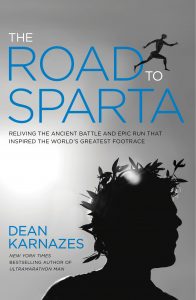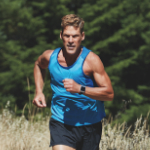
Dawn is the bewitching hour during an all-night run. Alertness slips to a low, and a sleep-inducing lethargy overtakes the system. As I ran through the misty predawn dreamscape of the Arcadian foothills, it remained a fight just to stay awake, as if tranquilizers had been infused into my bloodstream and small weights quietly attached to my eyelids. Lower and lower the shades drew across my field of vision.
Thump . . . thump . . . thump, the monotonous, rhythmic pulse of footsteps droned on metrically, like a vinyl record skipping a groove. Slowly, ever so gradually, my eyelids drooped downward, gradually darkening out what little light was left coming in. Still, I pressed on.
When I reopened my eyes, I found myself in the middle of the road. “What the heck?” I thought. I knew better than to place myself in that kind of danger. So I meandered back over to the shoulder and continued onward.
Then it happened again. I awoke, running down the middle of the road. That’s when I realized that I was sleep running. I was literally falling asleep on the run. I was so determined to keep going that I didn’t fall over or stop. I just continued running, willing my body onward, while asleep. How long I had been asleep and how much distance I had covered while in this state of nocturnal locomotion was difficult to ascertain (after all, I’d been asleep), but it was more than just a few short steps, and when I looked back to trace the spot of my last conscious recollection, it appeared to be quite some distance behind me, perhaps several hundred feet. Shocking!
Even more startling was the realization that after this second bout of comatose running I reemerged feeling somewhat refreshed and rejuvenated, as though my body needed rest so desperately it had forced itself into a temporary shutdown mode to allow the cerebral network to reboot. After these two brief catnaps, I now felt a bit more coherent.
I’ve since talked with other ultramarathoners who have experienced similar episodes of cataleptic nocturnal locomotion (i.e., sleep running). I’ve also read accounts of people in war-torn regions falling asleep in motion while trying to escape an enemy pursuer. And there are reports of combat soldiers having fallen asleep on the battlefield with one eye open, in watchful observation of potential threats during intense military conflicts.
Unihemispheric slow-wave sleep (USWS), or asymmetric slow-wave sleep, refers to the ability to put half of one’s brain to sleep while the other half remains awake. In contrast to normal sleep, in which both eyes are shut and both halves of the brain show reduced neural activity, during USWS only half of the brain is in deep sleep—a form of non–rapid eye movement sleep—and the eye corresponding to that particular half remains closed while the opposing eye remains slightly ajar. This phenomenon has not only been observed in chronically fatigued humans but also in a number of other terrestrial, aquatic, and airborne species, such as the swallows of California and Baja California, during extensive, transcontinental migrations in which they might go weeks or even months in motion without completing a single sleep cycle.
As the light of the looming sunrise progressively brightened the sky, my drowsiness subtly abated. The damp chill in the air lingered thick in the lowlands, and the morning stillness idly held this mist in an aerosol-like spray that coated my skin and hair in a fine layer of moisture. I shook my head back and forth several times, sending a shower of condensation from my hair, the crystalline dewdrops temporarily suspended in the fiery flare of the rosy-fingered dawn.
The road began to rise onto the high, flat plateau above Arcadia. The course proceeded through several sleepy villages and fertile groves of orchards, the fruit of which had been in existence since the time of Pheidippides’s own travels. Given Herodotus’s record, Pheidippides would have likely passed through this very same section of Arcadia in these same early morning hours, just as we were doing then. Would he have eaten from these same trees? To think that an ancient hemerodromos was running here 2,500 years ago fascinated me, and knowing that this was the land of my ancestral origins made the experience all the more visceral. I was connected to this place in ways I could not know. My forebears had walked these fields, tending to these very trees. The ancient Greeks believed they were of this land, soil-sprung. They hadn’t come here from somewhere else; they were autochthonous (earth-born), and this was the place of their origins, forever and always since the dawn of humanity. Formed from white rock and blue sea, my ancestors raised their families in this land fostered their hopes and dreams here, generation upon generation coming into and passing through life in these same hills and plains that I now ran through. This was their land, and in a timeless way, this was also my land.

Excerpted from The Road to Sparta, Chapter 27: Go Greek or Go Home, Copyright © 2016 by Dean Karnazes. Used with permission of Rodale, New York. All rights reserved.
Feature photo by Elias Lefas, Navarino Challenge
This information is for educational purposes only and is not intended as a substitute for medical diagnosis or treatment. You should not use this information to diagnose or treat a health problem or condition. Always check with your doctor before changing your diet, altering your sleep habits, taking supplements, or starting a new fitness routine.

If you have questions about a Fitbit tracker, product availability, or the status of your order, contact our Support Team or search the Fitbit Community for answers.
Please note: Comments are moderated and may not appear immediately after submission.